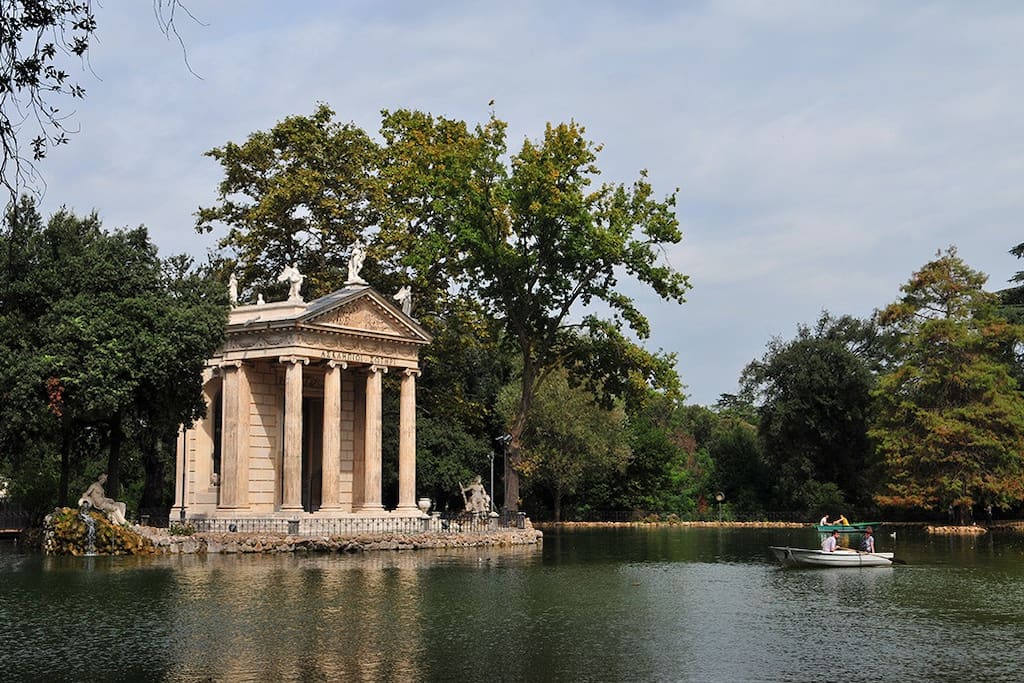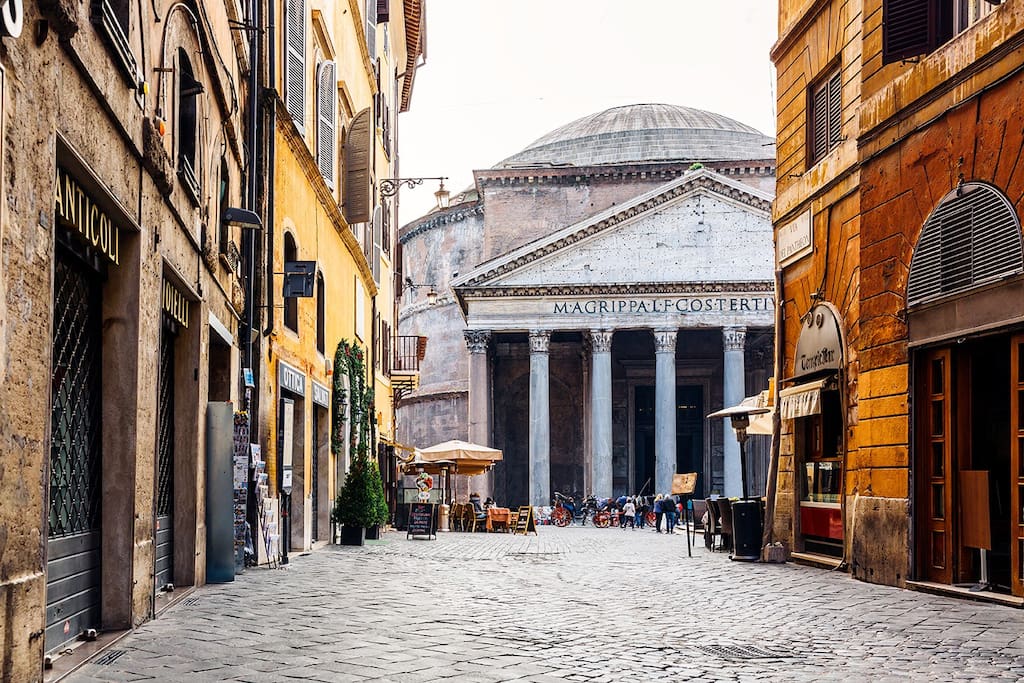Arts & Culture
If you come in Rome is quite impossible do not enter into one of the best museums in the world.
1756 paikallista suosittelee
Vatikaanin museot
If you come in Rome is quite impossible do not enter into one of the best museums in the world.
Piazza Navona is one of the most beautiful and representative Baroque square in Rome. It was built in an area where at the time of Caesar took gymnastics, and ludi Nero had built an amphitheater that Emperor Domitian became the Circus Agonis, built in travertine and brick.
Of all baroque squares in Rome, Piazza Navona occupies a special role because its main form was established in advance: it was determined by the emperor Domitian stadium that could hold about 30,000 spectators, and was used for the first time in 86 ad.
1722 paikallista suosittelee
Piazza Navona
Piazza NavonaPiazza Navona is one of the most beautiful and representative Baroque square in Rome. It was built in an area where at the time of Caesar took gymnastics, and ludi Nero had built an amphitheater that Emperor Domitian became the Circus Agonis, built in travertine and brick.
Of all baroque squares in Rome, Piazza Navona occupies a special role because its main form was established in advance: it was determined by the emperor Domitian stadium that could hold about 30,000 spectators, and was used for the first time in 86 ad.
This monument dates back to 13-9 BC, made of marble. It was built in Rome by the Emperor Caesar Augustus as a monument to the order and peace of his empire. The structure of the monument was typical of archaic Roman era and the style was traditional mixed archaic art attica. The ara, i.e. the altar itself, was a very simple construction and enclosed by walls of marble decorated. Within the walls there were beaded garlands while outside the wall is decorated on two sides: the lower one shows fitoformi reasons, i.e. plant forms. The upper band shows bas-reliefs with allegorical figures. The side walls depicts the same Augustus who participates in a procession with his entire family,
173 paikallista suosittelee
B&B Ara Pacis Augustae
35 Lungotevere dei MelliniThis monument dates back to 13-9 BC, made of marble. It was built in Rome by the Emperor Caesar Augustus as a monument to the order and peace of his empire. The structure of the monument was typical of archaic Roman era and the style was traditional mixed archaic art attica. The ara, i.e. the altar itself, was a very simple construction and enclosed by walls of marble decorated. Within the walls there were beaded garlands while outside the wall is decorated on two sides: the lower one shows fitoformi reasons, i.e. plant forms. The upper band shows bas-reliefs with allegorical figures. The side walls depicts the same Augustus who participates in a procession with his entire family,
Castel Sant'Angelo
50 Lungotevere CastelloVery amazing place in the center of Rome
If you come in Rome is impossible miss one of the most beautiful place in Rome!!Spanish Steps is one of my favorite place in Rome
1307 paikallista suosittelee
Piazza di Spagna
Piazza di SpagnaIf you come in Rome is impossible miss one of the most beautiful place in Rome!!Spanish Steps is one of my favorite place in Rome
The Fontana di Trevi - or Trevi Fountain in English -is a fountain in Rome, Italy. It is the largest Baroque fountain in the city and the most beautiful in the world.
A traditional legend holds that if visitors throw a coin into the fountain, they are ensured a return to Rome.
The fountain is worldwide famous but many people do not know the history and the secrets hidden behind its construction. It is time to do justice to this extraordinary masterpiece of Italian art.
1461 paikallista suosittelee
Trevin suihkulähde
Piazza di TreviThe Fontana di Trevi - or Trevi Fountain in English -is a fountain in Rome, Italy. It is the largest Baroque fountain in the city and the most beautiful in the world.
A traditional legend holds that if visitors throw a coin into the fountain, they are ensured a return to Rome.
The fountain is worldwide famous but many people do not know the history and the secrets hidden behind its construction. It is time to do justice to this extraordinary masterpiece of Italian art.
Galleria Borghese ja museo
5 Piazzale Scipione BorgheseColosseum
1 Piazza del ColosseoForums Impériaux
Via dei Fori ImperialiDrinks & Nightlife
Amazing cocktails in the center of Rome,easily to reach by subway,bus or by walking.
255 paikallista suosittelee
La Zanzara
84 Via CrescenzioAmazing cocktails in the center of Rome,easily to reach by subway,bus or by walking.
Parks & Nature
The Villa Borghese Park, one of the largest in Rome, is bordered by nine inputs which allow access from the central districts of the city, Flaminio and Pinciano, salary. The name of the villa derives from the former residence of Cardinal Scipione Borghese, the "noble Casino", built in the early seventeenth century designed by Flaminio Ponzio and Giovanni Vasanzio and transformed into the twentieth century art museum, one of the most prestigious collections of works of art from the 16th to the 18th century, with masterpieces by artists such as Raphael, Titian, Caravaggio, Bernini and Canova.
2099 paikallista suosittelee
Villa Borghese
Piazzale Napoleone IThe Villa Borghese Park, one of the largest in Rome, is bordered by nine inputs which allow access from the central districts of the city, Flaminio and Pinciano, salary. The name of the villa derives from the former residence of Cardinal Scipione Borghese, the "noble Casino", built in the early seventeenth century designed by Flaminio Ponzio and Giovanni Vasanzio and transformed into the twentieth century art museum, one of the most prestigious collections of works of art from the 16th to the 18th century, with masterpieces by artists such as Raphael, Titian, Caravaggio, Bernini and Canova.
Shopping
Mercato Rionale
60 Via FlaminiaYou will find typical Italian food very cheap
Via del Corso
Via del CorsoVia Cola di Rienzo
Via Cola di RienzoGetting Around
Very important Subway and train station.150 meters from the apartment
73 paikallista suosittelee
Valle Aurelia station
Very important Subway and train station.150 meters from the apartment
Sightseeing
The Colosseum, called by the ancient Romans "Anphitheatrum Flavlum", was built by the Emperor Vespasian in 72 AD about, and inaugurated by his son Titus in 80 AD
The construction took place in the area occupied by the enormous palace of Nero's Domus Aurea, and nearby there was a colossal statue of Nero, from which legend has it that the name derives Coliseum. After the killing of This statue was remodeled to represent the sun god.
2613 paikallista suosittelee
Colosseum
1 Piazza del ColosseoThe Colosseum, called by the ancient Romans "Anphitheatrum Flavlum", was built by the Emperor Vespasian in 72 AD about, and inaugurated by his son Titus in 80 AD
The construction took place in the area occupied by the enormous palace of Nero's Domus Aurea, and nearby there was a colossal statue of Nero, from which legend has it that the name derives Coliseum. After the killing of This statue was remodeled to represent the sun god.
The Roman Forum is the archaeological area between Piazza Venezia and the Coliseum, and crossed by the Via dei Fori Imperiali; continuing seamlessly on the Palatine and the Capitol, along with the area of Colosseum and the Arch of Constantine, is the largest and most important archaeological site in the world.
Originally occupied by marshes, the Forum area was reclaimed by one of the first urban works of ancient Rome: the Cloaca Maxima, a large water drainage system, so in the end there was nothing left but a pond, the lacus Curtius, which it must then be marked by a small monument, because now completely disappeared.
541 paikallista suosittelee
Fori Imperiali
The Roman Forum is the archaeological area between Piazza Venezia and the Coliseum, and crossed by the Via dei Fori Imperiali; continuing seamlessly on the Palatine and the Capitol, along with the area of Colosseum and the Arch of Constantine, is the largest and most important archaeological site in the world.
Originally occupied by marshes, the Forum area was reclaimed by one of the first urban works of ancient Rome: the Cloaca Maxima, a large water drainage system, so in the end there was nothing left but a pond, the lacus Curtius, which it must then be marked by a small monument, because now completely disappeared.
In order to visit the whole area of the Vatican it takes more than a day, whereas only a guided tour of the Vatican Museums will take almost a full day.
After the Sistine Chapel , the Rooms of Reffaello and other wonders of the Vatican Museums, you can devote another day to visit St. Peter's Basilica, where you can also climb up to the dome (the 'overlooking via St. Peter's Square is beautiful!) and Castel Sant'Angelo, where in some periods of the year is also open the Passetto, which is the passage that leads from the castle to the Basilica. Among a visit and another you can relax in the gardens of the castle or the Tiber, where in summer there are also many stands.
564 paikallista suosittelee
Vatikaani
In order to visit the whole area of the Vatican it takes more than a day, whereas only a guided tour of the Vatican Museums will take almost a full day.
After the Sistine Chapel , the Rooms of Reffaello and other wonders of the Vatican Museums, you can devote another day to visit St. Peter's Basilica, where you can also climb up to the dome (the 'overlooking via St. Peter's Square is beautiful!) and Castel Sant'Angelo, where in some periods of the year is also open the Passetto, which is the passage that leads from the castle to the Basilica. Among a visit and another you can relax in the gardens of the castle or the Tiber, where in summer there are also many stands.
The typical place where you can spend at least one evening in Rome in Trastevere, the popular district on the bank of the Tiber near the Tiber island full of traditional restaurants and pizzerias, and summer comes alive even more with the Festa de 'Noantri and many stand on Tiber and the Tiber Island for the event "along the Tiber in Rome .."
Trilussa square, crossing the Tiber on Ponte Sisto you get to Campo de Fiori , another typical place of Roman nightlife with many restaurants, pubs and pizza
1330 paikallista suosittelee
Trastevere
The typical place where you can spend at least one evening in Rome in Trastevere, the popular district on the bank of the Tiber near the Tiber island full of traditional restaurants and pizzerias, and summer comes alive even more with the Festa de 'Noantri and many stand on Tiber and the Tiber Island for the event "along the Tiber in Rome .."
Trilussa square, crossing the Tiber on Ponte Sisto you get to Campo de Fiori , another typical place of Roman nightlife with many restaurants, pubs and pizza
Even today, almost 2000 years after its construction, the breathtaking pantheon is a remarkable building to see. The spectacular design, proportions, elegance and harmony are a striking reminder of the architecture of the great Roman Empire. When Michelangelo saw this wonder for the first time he said that it looks more like the work of angels, not humans.
1342 paikallista suosittelee
Pantheon
Piazza della RotondaEven today, almost 2000 years after its construction, the breathtaking pantheon is a remarkable building to see. The spectacular design, proportions, elegance and harmony are a striking reminder of the architecture of the great Roman Empire. When Michelangelo saw this wonder for the first time he said that it looks more like the work of angels, not humans.





